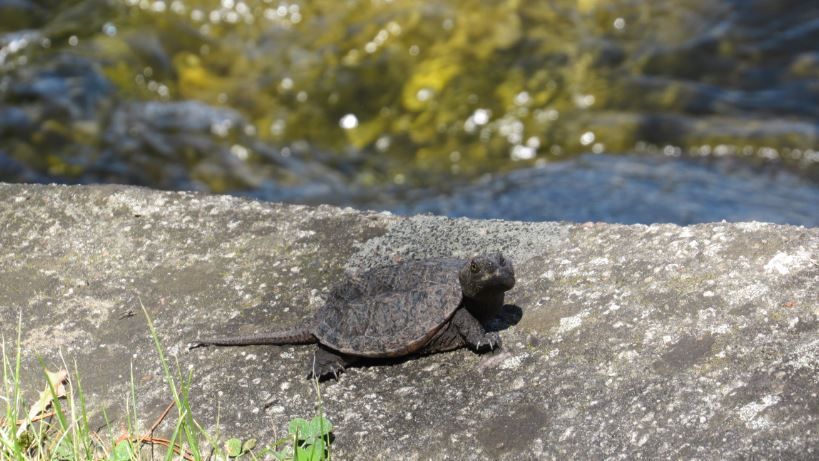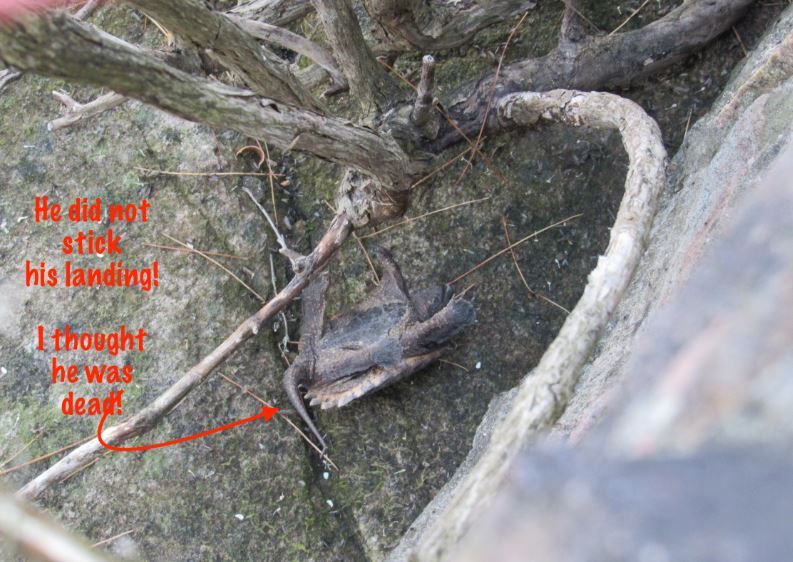I was reading in a shady spot on Rum Rock when I had this odd feeling that someone or something was watching me. I looked up from my book and appraised my surroundings. Through blades of grass, I caught the gleam of an eye fixed on me from the base of a pine tree. I stared back at the tiny, unblinking eye.

I stood to see that it was a tiny snapping turtle, small enough to fit inside the palm of my hand. We’ve had turtles pass through our little point before. The last to visit was a mature painted turtle, which paused to sun himself on our front rock before moving on to who-knows-where. I tried to return to my reading, but looked up often to find that tiny eye glaring at me as if it were I who had invaded his world.
A few pages later, I looked up just as our visitor took a step forward. It moved slowly through the tall grass. As it stalked forward, its eye remained fixed on me. It seemed to take forever for the tiny creature to move the six or seven feet from the tree trunk to the retaining wall. When the little turtle reached the wall, I assumed that it would turn and walk down to the water’s edge, but I was wrong. It climbed atop the wall, moved to the apex, and never took its eye from me.

Turtles are not an uncommon sight on the river. Mostly, I see painted turtles sunning themselves on shoreline logs as I kayak in South Bay. I remember the first time I saw a snapping turtle in South Bay. I noticed a large “something”—about the size of a manhole cover—swimming about a foot under the water. I paused and lifted my paddle. It swam directly beneath my kayak. It was huge!
I saw the same creature a few years later. I’d been hiking along South Bay Trail when a strange sound caught my ear. It sounded like a goon dragging a bad leg: crunch, slide, crunch, slide. I searched the underbrush and saw a giant snapping turtle coming down from the Pond Loop trail and heading toward the water. It paused when it saw me. I was disappointed that I didn’t have my camera with me. I was certain that it was the large turtle I’d seen while kayaking a few years before. It looked more enormous on land.

Careful not to get too close, I took my walking stick and laid it down next to the brute. From snout to tail, it was about five-feet long. Yowser! I picked up the walking stick and stepped back. Not that I was afraid it was going to lunge at me or anything, but my mother had told me, stories about snapping turtles.
When my mother was a girl growing up in Southern Illinois, she and her sister were excited when they came across snapping turtles when walking home from school. They would put a stick in front of it and the beast would bite down. “Once a snapping turtle bites down on something, it will not let go,” she had told me. Using the stick as a handle, my mother and her sister would drag the turtle home between them.
I wondered aloud why they would want such a fierce pet and she laughed. They weren’t thinking pet. They were thinking dinner. She told me that snapping turtles were good eating. Both her parents would be pleased. Her father would kill it and remove its shell and her mother would cook it up for dinner.
The monster I’d seen on the South Bay trail could have fed a family of ten. Remembering the story my mother had told me decades before, I doubt my mother and aunt could have dragged such a monster home between them. But it got me wondering. How did one prepare turtle? And, what did it taste like? I was too horrified to ask those questions when I was a child.
My mother had passed, but my father was still alive then. I called him that afternoon and asked if he knew how turtle was prepared. As luck would have it, my father had been at his future in-law’s home one night when they served snapping turtle. He said that he thought it had been fried. The odd thing was that the turtle had seven different types of meats, each with its own distinct taste: some parts tasted like pork, other parts like chicken, beef, or seafood. It was the first and only time he had had snapping turtle, and he said it was quite good.


Our little visitor was so small; it wouldn’t have fit on a cracker. I looked up to find our little visitor at the top of the wall glaring at me as if he knew what I was thinking about. At that precise instant, the turtle stepped off the top of the wall and disappeared from view. I jumped up and dashed to the wall. It’s about a four-foot drop from the top of the wall to the rocks below. I peeked down, hoping to see that the little guy had landed on its feet. Instead, the turtle was upside down, its clawed feet sticking up in the air and unmoving. I feared it was dead.


I moved to the North Rock where I could observe the turtle and continued to read. I’d finished another chapter before I saw the first hint that the little guy was still alive. It took him three or four minutes to flip from belly-up to right-side-up. I thought my high-diving visitor would quickly leave. I don’t think “quickly” is in its vocabulary. After resting a bit, it slowly moved to the water’s edge and sat there a long while as if undecided as to whether it should leave or not.

Finally, the decision was made for it. A cruiser went by throwing up a massive wake, which washed the turtle off the rock and into the water. I searched the churning water for the little thing, but I never saw it again. Hope the little guy exercises better judgment in the future and curbs his daredevil, high-diving tendencies. There are lots of critters that prey on tiny turtles: birds, raccoons, fox, and other turtles. But once it reaches a certain size—its only predator is human. He has nothing to worry about from me. I hope to see that alert, gleaming eye again.
By Lynn E. McElfresh, Grenell Island
Lynn McElfresh delights us every single month... this month's article is just as wonderful as her first, written in August 2009. She has taken us on so many journeys into the past as well as introducing us to some amazing people, places and things! This one hits the mark once again. (See her first 109 articles here!)
Lynn came to Grenell Island for the first time to meet her fiancé’s family, in 1975. She became part of the family, and the island became part of her life. Lynn and her husband, Gary, spend their summers in the Thousand Islands and their winters in Dunedin, Florida. To see the rest of Lynn’s island experiences, search our new TI Life format under Lynn McElfresh.
Lynn has also written two novels in a series of nine novels about life in the Islands from 1883 to the 1960s. The third book, Grenell 1904, is almost here... and the fourth, Grenell 1912, is well underway!
See All About Lynn McElfresh & Her Books, in September, 2020 issue of TI Life.
Posted in: Volume 15, Issue 12, December 2020, Nature
Please click here if you are unable to post your comment.
